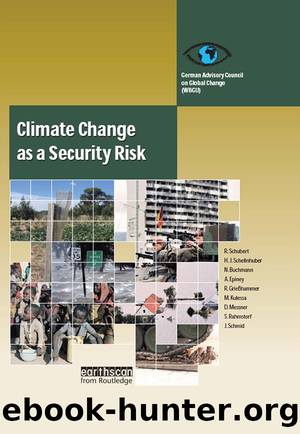Climate Change as a Security Risk by Hans Joachim Joachim Schellnhuber

Author:Hans Joachim Joachim Schellnhuber [Schellnhuber, Hans Joachim Joachim]
Language: eng
Format: epub
Tags: Public Policy, Science, International, Global Warming & Climate Change, Political Science, Security (National & International), Law, General, Environmental Policy
ISBN: 9781136535642
Google: 9isCgzsLqxoC
Goodreads: 17545515
Publisher: Routledge
Published: 2009-12-12T00:00:00+00:00
6.5.4.3
Supporting developing countries
Migration currently takes place mainly within and between developing countries; it seems that this continues to be the case where environmentally induced migration is concerned (Clark, 2006). On account of inadequate infrastructure, the lack of political and economic stability and limited economic capacity, developing countries must also be regarded as particularly susceptible to conflict. Implementation of the measures described above for managing environmentally induced migration in these countries therefore requires international donors to play a part in coordination and funding. An appropriate forum for discussion of these issues might well be the International Dialogue on Migration set up in 2001 by the International Organization for Migration (IOM, 2001). The Dialogue could also serve as a platform for organizing a system by means of which costs can be fairly and efficiently shared between affected and unaffected countries (Section 10.3.4.3).
Particular challenges arise in dealing with environmental migrants who are classed as Internally Displaced Persons (IDPs) in their country of origin. Compared with cross-border refugees, IDPs have only limited protection under international law, even when they are victims of internal unrest and armed conflict (Geissler, 1999; Phuong, 2004). In such cases the international community can only complement the work of national bodies when affected governments are themselves unable to ensure the welfare of IDPs. The leading role in caring for IDPs is played by the UNHCR, with the support and cooperation of other UN organizations and relevant NGOs (in particular the International Red Cross and the International Organization for Migration) (Phuong, 2004; OHCHR, 2006; UNHCR, 2006a). There is, however, as yet no procedure for the binding allocation of responsibilities under international agreements. In order to deal appropriately in future with the pressing problems of internal environmentally induced migration, these omissions in the provisions of international agreements should be remedied.
Economic and social development is in itself an effective strategy for preventing environmentally induced migration, because it strengthens countriesâ ability to adapt to environmental changes, increases the capacity of institutions to regulate migration movements and thus reduces susceptibility to security risks arising from environmentally induced migration. In addition, the closer networking of development, environmental and migration policy should be pursued; this would facilitate the identification of related problems and the utilization of synergy effects in selecting appropriate instruments (WBGU, 2005; Section 10.3.4.3).
Download
This site does not store any files on its server. We only index and link to content provided by other sites. Please contact the content providers to delete copyright contents if any and email us, we'll remove relevant links or contents immediately.
How to Do Nothing by Jenny Odell(3232)
A Forest Journey by John Perlin(3027)
The Plant Messiah by Carlos Magdalena(2883)
Babylon's Ark by Lawrence Anthony(2620)
The ESV Study Bible by Crossway Bibles(2502)
Energy Myths and Realities by Vaclav Smil(2438)
Fatal Storm by Rob Mundle(2171)
Abbey in America by Murray John A(2050)
Witness Tree by Lynda V. Mapes(1888)
Brokeback Mountain by Annie Proulx(1782)
Client Earth by James Thornton(1735)
Shadows on the Gulf by Rowan Jacobsen(1717)
Coming Back to Life by Joanna Macy(1685)
Cosmos by Carl Sagan(1681)
Water Rights and the Environment in the United States by John Burch(1643)
Mycelium Running: How Mushrooms Can Help Save the World by Paul Stamets(1642)
Ten Billion by Stephen Emmott(1611)
The overachievers by Robbins Alexandra(1528)
Ecological Intelligence by Daniel Goleman(1507)
